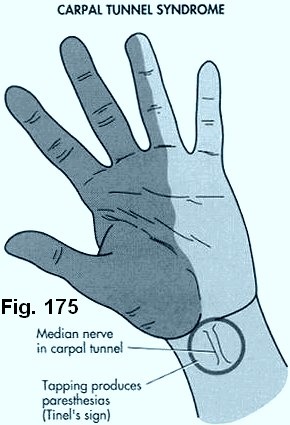Table 18.1 Nomenclature of bone tumors
Carpal tunnel syndrome
BASIC INFORMATION
DEFINITION
Carpal tunnel syndrome is an entrapment neuropathy involving the median nerve at the wrist (Fig. 175). It is the most common entrapment neuropathy in the upper extremity.
Carpal tunnel syndrome, a “nocturnal troublemaker” like the radicular pain syndromes, is rightfully called “brachialgia paresthetica nocturna.” Typically, it starts with a tearing pain in the hand or arm, always with numbness or tingling, at night or early in the morning. Shaking or massage quickly alleviates the pain. During daytime, tingling or numbness occurs in one or in all fingers that are innervated by the median nerve; initially only after work, later permanently. Numbness in the fingertips, reduced fine motor coordination, and, often late in the course, atrophy of the thenar muscle, are indicative. The Phalen test and electrodiagnostic tests confirm the diagnosis. Difficult to distinguish in a differential diagnosis are the C6 radicular syndrome (tingling in the thumb and index finger) and C7 (index and middle finger). The segmental sensory disturbance of the radicular syndrome with the inclusion of the dorsal hand area and the forearm, reflex differences, and most importantly cervical radicular provocation maneuvers and radiographic studies of the cervical spine in four planes, clarify the diagnosis.
EPIDEMIOLOGY & DEMOGRAPHICS
PREVALENT AGE: 30 to 60 years (bilateral up to 55%)
PREVALENT SEX: Females are affected two to five times as often as males
PHYSICAL FINDINGS & CLINICAL PRESENTATION
• Nocturnal pain
• Occasional median nerve sensory impairment (often only index and long fingers)
• Positive Tinel’s sign at wrist (tapping over the median nerve on the flexor surface of the wrist produces a tingling sensation radiating from the wrist to the hand)
• Positive Phalen’s test (reproduction of symptoms after 1 minute of gentle, unforced wrist flexion)
• Carpal compression test: Pressure with the examiner’s thumb over the patient’s carpal tunnel for 30 sec elicits symptoms
• Thenar atrophy in long-standing cases
ETIOLOGY
• Idiopathic in most cases
• Space-occupying lesions in carpal tunnel (tenosynovitis, ganglia, aberrant muscles)
• Often associated with hypothyroidism, hormonal changes of pregnancy
• Job-related mechanical overuse may be a risk factor
• Traumatic injuries to wrist

DIAGNOSIS
DIFFERENTIAL DIAGNOSIS
• Cervical radiculopathy
• Chronic tendinitis
• Vascular occlusion
• Reflex sympathetic dystrophy
• Osteoarthritis
• Other arthritides
• Other entrapment neuropathies
IMAGING STUDIES
Routine roentgenograms may be helpful in establishing cause or ruling out other conditions.
ELECTRODIAGNOSTIC STUDIES
Nerve conduction velocity tests and electromyography are useful in establishing the diagnosis and ruling out other syndromes.
TREATMENT
ACUTE GENERAL Rx
• Elimination of repetitive trauma
• Occupational splints or braces
• NSAIDs
• Injection of carpal canal (avoiding median nerve)
• Low-dose oral corticosteroids (e.g., prednisolone 20 mg qd for 2 weeks, followed by 10 mg qd for 2 more weeks) are also effective for symptom relief in selected patients.
DISPOSITION
Prognosis is variable. Some cases resolve spontaneously. Relief from local injection appears transient and symptoms recur in the majority of cases following injection.
Carpal tunnel syndrome is common in the third trimester of pregnancy, but symptoms subside after delivery in most cases, often dramatically. Symptoms may recur with subsequent pregnancies. Surgery is not recommended in pregnant patients because of the likelihood of spontaneous recovery.
DIFFERENTIAL DIAGNOSIS
• Cervical radiculopathy
• Chronic tendinitis
• Vascular occlusion
• Reflex sympathetic dystrophy
• Osteoarthritis
• Other arthritides
• Other entrapment neuropathies
IMAGING STUDIES
Routine roentgenograms may be helpful in establishing cause or ruling out other conditions.
ELECTRODIAGNOSTIC STUDIES
Nerve conduction velocity tests and electromyography are useful in establishing the diagnosis and ruling out other syndromes.
TREATMENT
ACUTE GENERAL Rx
• Elimination of repetitive trauma
• Occupational splints or braces
• NSAIDs
• Injection of carpal canal (avoiding median nerve)
• Low-dose oral corticosteroids (e.g., prednisolone 20 mg qd for 2 weeks, followed by 10 mg qd for 2 more weeks) are also effective for symptom relief in selected patients.
DISPOSITION
Prognosis is variable. Some cases resolve spontaneously. Relief from local injection appears transient and symptoms recur in the majority of cases following injection.
Carpal tunnel syndrome is common in the third trimester of pregnancy, but symptoms subside after delivery in most cases, often dramatically. Symptoms may recur with subsequent pregnancies. Surgery is not recommended in pregnant patients because of the likelihood of spontaneous recovery.
Common regional musculoskeletal problems.

Contacts: lubopitno_bg@abv.bg www.encyclopedia.lubopitko-bg.com Corporation. All rights reserved.
DON'T FORGET - KNOWLEDGE IS EVERYTHING!